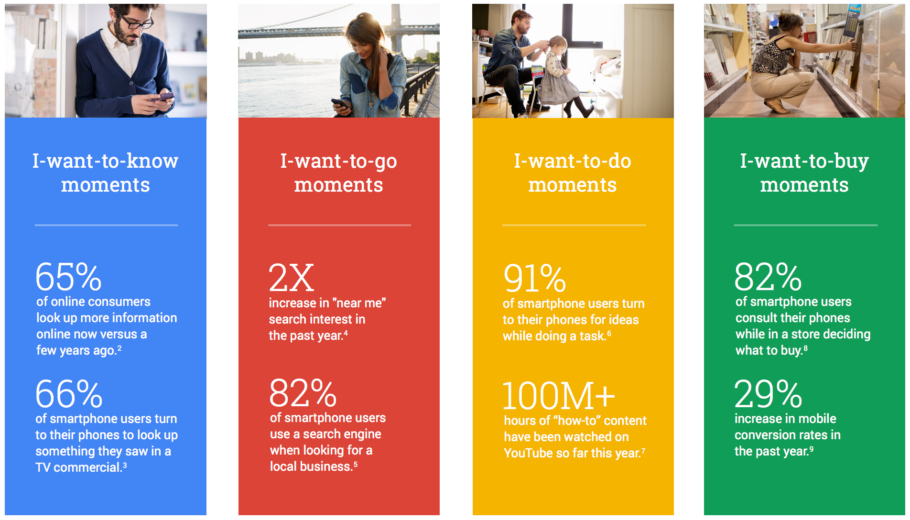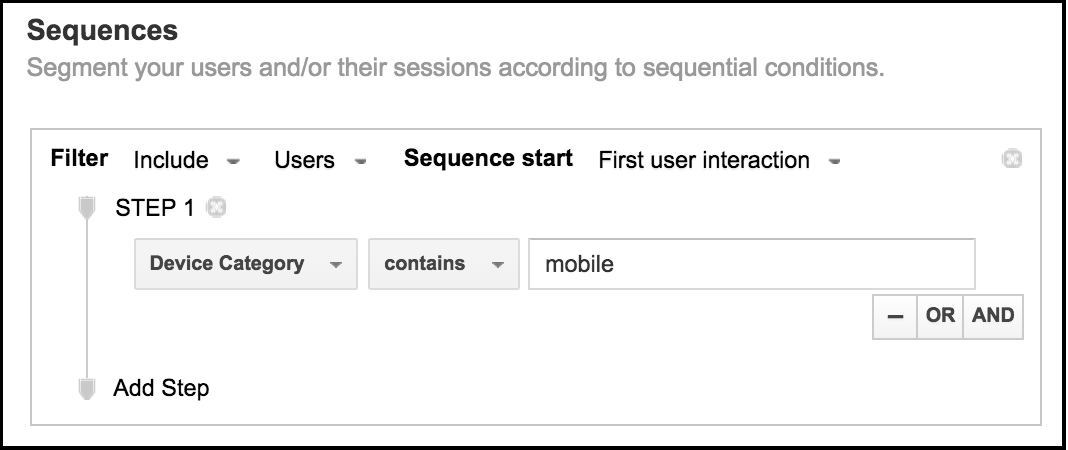On May 5th, Google introduced Micro-Moments.
“Mobile has forever changed the way we live, and it’s forever changed what we expect of brands. It’s fractured the consumer journey into hundreds of real-time, intent-driven micro-moments. Each one is a critical opportunity for brands to shape our decisions and preferences.” – Google
As smartphone searches are on the rise, Google is learning more and more about the situations in which users are searching, as well as their behavior after the search. The gist of micro-moments is that consumers are using their mobile devices to perform quick queries in the moment, right when they need the information.
You may be thinking to yourself “well, this is great and all, but what do I do with this information?” We’ll go through what it means, and what you can do in your accounts to take advantage of these micro-moments.
Breaking It Down
Let’s go through a quick outline of what you can do in your marketing efforts to understand and implement strategy based on micro-moments:
- Make a moments map that examines the entire consumer journey. Take note of every single step of the funnel, from “I have a problem” to “I’m ready to purchase”.
- At each step of the way, understand the customer needs at that exact moment.
- Once you have a solid understanding of the mindset and needs of the consumer, use context to deliver the right experience. Using location targeting/extensions is a great way to provide context to users who are nearby or searching for a brick and mortar location.
- Optimize across the journey. Revolve your strategy around the individual user and organize around moments.
Four Moments To Be Aware Of
People want immediate answers. Google breaks down these types of searches into four categories:
- I want to know
- I want to go
- I want to do
- I want to buy

Which of these moments are relevant to you is going to depend on your account. For example, if you sell products online but also have brick and mortar stores, all four could potentially apply. The trick is knowing how to distinguish when a user is in a particular moment, and what kind of messaging to serve them.
Practical Implementation
A good place to start would be to take a look at your mobile search queries. If you see any trends, for example, something like “were can I buy” or “how do I fix,” you might consider throwing these terms into their own campaign/ad groups, so you can tailor mobile specific ad copy (and maybe implement a positive mobile bid modifier). Google reveals that 82% of smartphone users turn to their phone to influence a purchase decision while in a store. Knowing that statistic definitely has the potential to alter the way many digital marketers approach mobile strategy.
Next, pay close attention to your ad copy. Write your ad to appeal to the raw thought that sparked the search. These “in the moment” type queries are usually exactly what the user is thinking, i.e., “how do I find the best running shoes.” Focus on what kind of information that user needs in that exact moment. Is it information? A phone number? A physical address?
Remarketing can play a huge part here. Thanks to Google Analytics, you can create audience lists that include users who visited your site for the first time on a mobile device:
Specific remarketing audiences will also allow you to tailor ad copy. A user who has viewed your pricing page might be enticed back to the site with a promo code or free trial offer. I encourage you to take a look at your existing remarketing strategy and brainstorm ways to make it more effective. As they say, always be testing!
So What?
We’ve known for a long time that mobile search traffic is increasing, so what’s different now? Well, now the focus is more heavily placed on the user, and the situation and intent in each specific moment in the buying cycle. Users are starting the purchase/lead process from mobile devices and finishing from their desktops, leading to a rise in cross-device conversions.
Does it matter for my account? The answer is maybe.
Every business and account is going to have a different strategy around micro-moments that are heavily impacted by its unique customer base and target audience. If I’m running ads for an emergency plumber, mobile searches and phone calls are going to be a very important part of my strategy, as those users need the service right now. If I’m running ads for a B2B lead generation client, mobile may play a smaller part in our marketing efforts.
The main takeaway is that you should be sure to think about the entire purchasing journey as it pertains to your specific account. Take some time to consider if you’re using the right messaging at the right time. I don’t think this necessarily means to start from scratch and throw out your old strategy, but rather take the opportunity to test new ideas.
Cross-device conversions is a bit of a murky metric, with Google using stats from users who were signed into their Google accounts on both devices to approximate the total number of conversions. Since this number is not precise, I wouldn’t recommend making substantial optimizations based upon it. Instead, just use it as more of a guideline and extra information.
As Google gathers more and more data to drive insight into user behavior and purchasing journeys, we can use it to our advantage as digital marketers. It also points to a shift in PPC strategy as a whole, to thinking about the bigger picture as opposed to just users who are looking to purchase right now. The purchase journey can be very complex, and while we still don’t have completely accurate data, we’re heading in the right direction in terms of strategy and big picture thinking.





